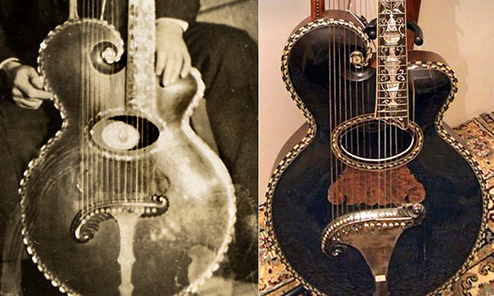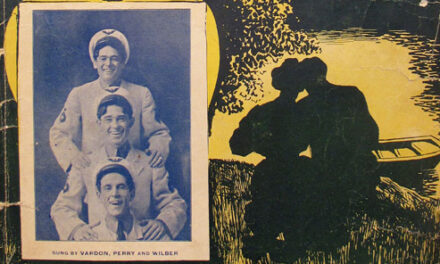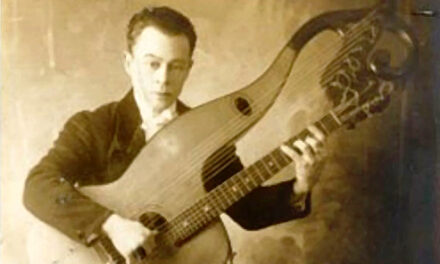You may recall my revelation 2-1/2 years ago about the fanciest Gibson harp guitar ever built – serial # 5703 – that I included in my article on Gibson World’s Fair Harp Guitars. Though rumored to “have been built for the World’s Fair,” I believe I demonstrated otherwise. So what was it?
Well, turns out that I had images of it already – historical images!
Yes – I hadn’t yet published and had completely forgotten about this Crescendo image from February, 1916, depicting the Kalamazoo Y.M.C.A. Mandolin Orchestra, Jas. H. Johnstone, Director (formed in September, 1915).

Could that be #5703?
It gets better.

Continuing through my ever-expanding “To Do” file folders, I found a wonderful set of photographs submitted by a fellow named Rik Lovelady. Rik’s great uncle, Will Hollenbeck, worked for Gibson and played flute in the orchestra. He didn’t know if his uncle was among the players in the three photos he sent (no flute player is present), but our supposition was that the ensembles – which consist of many of the same faces in each image – were made up of Gibson employees. One of Rik’s photos was the same Crescendo YMCA group image, and the others seemed to consist of the same folks (newspaper clippings reveal that the same players would appear in a single concert under multiple Gibson ensemble names).



In the first two of Rik’s images, one of the men holds what is undoubtedly #5703. This same man holds a mando-bass in Rik’s third photo and also in a fourth image of the group from another Crescendo entry four months after their first. With such a specific harp guitar customization, it’s pretty easy to corroborate (the possibility of a duplicate being pretty slim, I’d say). Compare the images and see what you think.

(I have morphed the extant instrument on the right to better align its face to the historical instrument’s face; there are still significant perspective differences)
We can now see what #5703 looked like originally. I had wondered if the headstock inlay was original, as it doesn’t seem to match the style of the neck inlay – but we can clearly see that both were original (or at least customized in this way by 1916). The new images show that it had a typical Gibson metal strap support, which was later replaced by a crude oversize version. The Orville-style centered inlaid pickguard is the most unusual feature, but was original to the instrument (again, at least by these 1916 photo sessions). You can just make out the same distinct outline in the closeup above.
Unfortunately, the photos – nearly ten years after the suspected date of construction – don’t tell us much about its origins, beyond the fact that it appears in a group chock-full of Gibson employees.
An obvious supposition is that the player was a Gibson employee, and that this might have been his own custom instrument – perhaps even by his own hands in some capacity. We can even guess his name – one of three possibilities provided by the first Crescendo caption above. Though only two harp-guitarists are shown, they list three players: Fred Petrie, H. F. Pleus (actually Harold Plews) and Harry Moerdyk. Were any of them Gibson employees?
Peggy Joyce Brumbaugh, author of an upcoming book on Orville Gibson, graciously did my homework for me. She found that Fred W. Petrie did work briefly at Gibson, but seems to have wandered from job to job. His obituary states that he was “a musician and World War I veteran.” Harry Moerdyk spent most of his adult life working for the Kalamazoo Stove Company. Peggy found no mention of him as a musician other than the YMCA Orchestra. Harold Plews, whose wife and brother also played in the Gibson groups, was an amateur musician who moved to Washington DC around 1919, where he worked for the Federal Trade Commission. While in D.C. he continued playing guitar with the Nordica Mandolin and Guitar Orchestra. Peggy found nothing prior to 1919 to prove a job at Gibson. Plews spent the rest of his life as an accountant/auditor for a baking company. The couple moved around quite a bit, especially in California in the 1940s and 1950s, and never had any children.
Peggy did find one compelling piece of additional evidence: two Kalamazoo newspaper clippings of concerts by the YMCA Mandolin Orchestra (the same group in the Crescendo write-up). Along with Rik’s great uncle Will on flute, these listed Harold Plews as the mandobassist. As two of the four photos show our harp guitar player with the mandobass, I think we can go out on a limb here and narrow down our likely #5703 owner to Harold Plews. We still don’t know whether he was a Gibson employee or whether he was just a local amateur musician who joined in with Company employees in their mandolin groups. We also don’t know if he did indeed own or commission the instrument, though there’s no reason to think otherwise. I just wish we knew more about him to piece this origin story together. He was playing the instrument in 1915-1916, but it was surely built earlier (my guessitmate of c.1906 still stands). As Plews had no descendants, there would have been no one to hand it down to, and Peggy wonders if he might have pawned it as he went off to war, as was common with WW1 enlisted men.
Lost and now found, it will remain in private hands until its future owners decide its next fate.

(More details on this instrument and how I date it can be found in Chapter 6 of Gibson Harp Guitars: To the World’s Fair and Beyond!







Absolutely wonderful article. We were sitting on a lazy Saturday morning listening to Michael Hedges Oracle and I was showing my wife pictures of Michael with his harp guitar. When I was looking for classic images of Gibson arch tops we ran across your article. What a spectacular instrument! A great article and historical research. It reminded me of something a violin broker told us when acquiring an instrument for our son – that these delicate instruments can far outlive us. Thanks. David